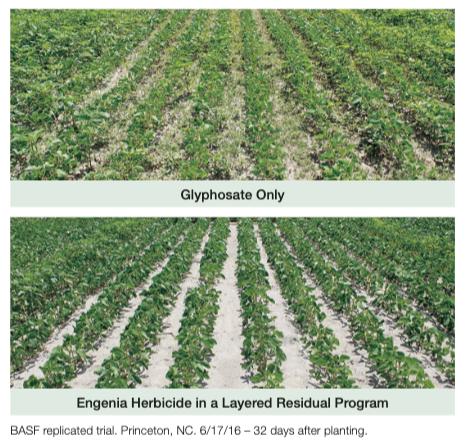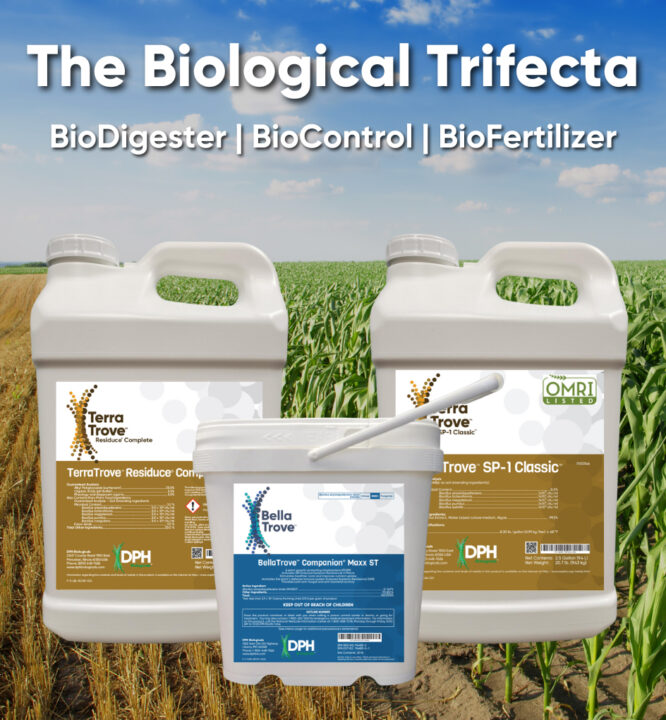Stewardship Critical for Soybean and Cotton Dicamba Applications
Early season weed competition can be detrimental to yield, therefore, effective herbicide options are crucial for a successful weed control program. Not only is weed competition a physical challenge for growers, it also can have a significant financial impact. With just eight plants per meter, yield loss in soybean can be up to 56% and 79% for waterhemp and Palmer amaranth, respectively.1 Dicamba-based herbicides, like Engenia herbicide, provide consistent and reliable control of weeds that have developed resistance to other chemistries.
 Based on BASF’s proprietary BAPMA technology, Engenia herbicide offers the most advanced dicamba formulation on the market. It has the lowest use rate available for dicamba-tolerant crops and offers the lowest volatility dicamba salt. Engenia herbicide controls more than 200 broadleaf weeds, including many that have developed a resistance to glyphosate, and provides an additional effective site of action.
Based on BASF’s proprietary BAPMA technology, Engenia herbicide offers the most advanced dicamba formulation on the market. It has the lowest use rate available for dicamba-tolerant crops and offers the lowest volatility dicamba salt. Engenia herbicide controls more than 200 broadleaf weeds, including many that have developed a resistance to glyphosate, and provides an additional effective site of action.
When using dicamba over the top of DT soybeans and cotton, it is important to minimize potential of volatility and drift. In addition to following all federal and state label requirements, agronomic experts at BASF recommend additional best practices to keep dicamba applications on target every time.
“With increased weed resistance, the need for dicamba-based herbicides, like Engenia herbicide, is greater than ever before,” said Andrew Adams, BASF Stewardship Manager. “Product stewardship is a fundamental part of what we do for our products. For Engenia herbicide, we are constantly looking for solutions that further reduce the risk of off-target movement for every application.”
Dicamba Stewardship
Planning to apply a dicamba-based herbicide? Here’s a quick checklist:
Do:
- Use an approved pH buffering adjuvant, like Sentris Buffering Technology, in every application. Unlike other dicamba formulations, Engenia herbicide does not always need an additional drift-reducing agent. Refer to EngeniaTankMix.com for a list of approved pH buffering adjuvants and other tank mix partners.
- Use approved nozzles and tank mix partners.
- Only spray when wind speed is between 3 and 10 mph.
- Only apply one hour after sunrise and until two hours before sunset.
- Spray at a ground speed of 15 mph or less.
- Follow EPA spray buffer requirements, accounting for windspeed and endangered species assessment requirements.
- Limit to two post over-the-top applications.
- Create records within 72 hours, including applicator, product and planting information, application parameters, pH buffer adjuvant and use rate, tank mixes, tank cleanouts, spray conditions, and spray buffer zones.
- Follow all state and local requirements.
Do Not:
- Do not spray if wind is blowing toward neighboring sensitive crops, residential areas or other sensitive areas.
- Do not apply when temperature inversions exist at the field level.
- Do not apply after cutoff dates (June 30, 2021 for soybeans and July 30, 2021 for cotton).
Tank Mixing Order with Sentris Buffering Technology
BASF is aware of the blog and videos posted by the University of Arkansas regarding mixes of Sentris Buffering Technology, Engenia herbicide and glyphosate in 3L bottles. The mixing, immediate capping of the bottles, and agitation does not represent any real-world scenario encountered by applicators when using Sentris Buffering Technology.
BASF remains confident in the performance of Sentris buffering technology, and wants to reassure applicators that it is safe to use as a pH buffering adjuvant with approved tank mix applications that contain dicamba and glyphosate for over-the-top applications on dicamba-tolerant soybean and cotton.
Sentris buffering technology has been used successfully in BASF trials and by applicators in the field during the 2021 season. BASF has not received any complaints regarding Sentris Buffering Technology and glyphosate when the proper mixing order has been followed.
Required annual training available through BASF
Did you know BASF has trained more than 68,000 applicators? Keep skills sharp in stewardship areas, including but not limited to proper nozzle selection, calibration, boom height, weather conditions and the use of approved tank mixtures. For more information and to register for the required training, visit EngeniaStewardship.com.
1 Hartzler, Bob. “Palmer amaranth: ID, biology and management.” Iowa State University, https://crops.extension.iastate.edu/palmer-amaranth-id-biology-and-management





